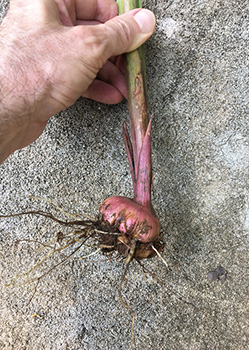Bulbs for Florida

Certain plants have underground storage organs called bulbs. These have adapted for nutrient and water storage during dormancy or extended periods of stress due to cold, heat, or drought.
Bulbs, such as tulips, are well-known for their spring show in colder climates, but you can grow bulbs in Florida, too. The wide variety of tropical and subtropical bulbs suited for Florida include crinum, cannas, amaryllis, and more.
Bulbous plants can be used in landscapes as bedding plants or borders and can be cut for indoor arrangements.
In general, most bulbs thrive in sunny locations, but some, like caladiums, can grow in sun or partial shade. Avoid heavy shade because it’ll cause thin, spindly growth and poor foliage color and flowering.
Your site should be well-drained and improved with organic matter. Place your bulbs in neat rows or in naturalistic drifts for an informal garden effect. Add some bulbs to your landscape for years of color and enjoyment.
Some bulbs for Florida on Gardening Solutions
- Agapanthus
- Amaryllis
- Blood Lily
- Cannas
- Crinum Lilies
- Crocosmia
- Hurricane Lily
- Rain Lilies
- Society Garlic
- Spider Lily
Fall Bulbs
Bulbs aren’t just for spring and summer; several kinds of bulbs can be planted in the autumn in Florida. Unlike tulips and many other bulbs, these bulbs don’t need to chill before blooming.
The gladiola produces tall spikes of large blossoms in a rainbow of colors. It can be planted anywhere in the state, and will bloom within three months of planting.
For Central and South Florida, try society garlic. This grassy-looking plant sprouts large clusters of delicate lavender flowers.
Amaryllis, with its large funnel-shaped flowers, is commonly planted in containers in late fall for holiday color.
Starting Summer Bulbs in Pots
In the spring, get a head start with caladiums, cannas, blood lilies, and other summer flowering bulbs by starting them in pots.
Gather some 6- to 8-inch pots, and fill them with a good, well-drained potting media. Place a bulb or tuber in each pot, taking care to plant them at the correct depth and orientation. For caladiums, also use a sharp knife to remove the central eye on each tuber so that you’ll get fuller plants.
Place the pots where they’ll stay warm and receive adequate sunlight. Don’t forget to water them when the soil feels dry to the touch.
When temperatures start to rise, move the pots into the garden to help them get acclimated, and then plant them out in the landscape. By using this trick, you’ll be able to enjoy great color earlier in the season.
For more on bulbs, and plants that you might think are bulbs, but really aren’t, read “Is this a Bulb?”
Propagation, or Dividing Bulbs
In Florida, early fall is a good time to divide bulbs. These plants develop “baby” bulbs, which, when grown to full size, are known as offsets. To divide bulbs, simply separate these offsets and replant them, pointy end up, to create new plants. Store bulblets in a cool, dry place for up to a week before planting.
Bulbs like amaryllis can be propagated by cutting them into wedges. Apply a fungicide dust, and plant each section, from which new plants will grow.

